Research - (2022) Volume 10, Issue 1
Knowledge and Awareness about Forensic Entomology in India among Dental Students
Taanya Imtiaz and Abirami Arthanari*
*Correspondence: Abirami Arthanari, Department of Forensic Odontology, Saveetha Institute of Medical and Technical Sciences, Saveetha University, India, Email:
Abstract
Introduction: Forensic science deals with various branches, which involve the identification of the dead and also reveals the suspect of the crime. Thus a branch of forensic science is forensic entomology, which is a study that deals with insects and arthropods in a criminal investigation. Insects are used to estimate PMI-post-mortem interval because of the reproductive stage taking place in the dead and decayed corpse. Thus the aim of this study is to investigate the awareness and knowledge about forensic entomology among dental students. Materials and methods: Detailed questionnaire was created with questions about forensic entomology and was circulated to 100 dental undergraduate students through Google forms. The collected data was analysed using chi-square analysis in SPSS software. Results: 83.3% of the dental students are aware about forensic entomology and 73.3% of the dental students are aware that it's a study of the insects which is helpful in forensic investigations to determine the PMI. Are aware that PMI helps to determine and estimate the time of the deceased. 63.3% of them are aware that forensic entomology is linked with forensic odontology. Conclusion: Thus the present study concludes that the awareness and knowledge about forensic entomology among dental students is above average, and the various aspects of forensic entomology are well known by the second year students than the first year students.
Keywords
Forensic entomology, Insects, Awareness, PMI, Dental students, Eco-friendly, Innovative technology
Introduction
Forensic science deals with various branches, which involve the identification of the dead and also reveals the suspect of the crime. Thus a branch of forensic science is forensic entomology, which is a study that deals with insects and arthropods in a criminal investigation. The application of forensic entomology in forensic science is to identify the time and place of death [1]. The most commonly involved insects in forensic entomology are blowflies, maggots, and beetles. The molecular DNA level of studying these insects reveals the suspect of the criminal case, location of death, and changes made in the position of the corpse [2]. Investigation at the molecular level of the deceased gives an exceptional view to the crime cases [3].
Insects are used to estimate PMI- post-mortem interval because of the reproductive stage taking place in the dead and decayed corpse [4]. Post-mortem interval reveals the time between the death of the person till the finding of the corpse. It is highly applicable and useful in crime branches to have an accurate plan of the crime taken place [5]. Mainly the larval stages of the insects give a clear view of identifying the crime time and location. The insects and arthropods play a crucial part in determining the crime theme in history. Flies are possibly the first most attracted insects to corpses and dead remains, blow files are the most relevant flies used in forensic entomology to estimate the PMI which was mentioned in the late 19th century [6].
The wide applicative ranges of forensic entomology in forensic investigations have helped to evaluate the anatomy of different insects [7]. The further investigation of the corpse gives accurate findings that relate the atmosphere and temperature of the crime scene taken place, by the basic information sourced the involvement of the insects is studied to find the exact motion of the crime scene [8]. It is important for a forensic deontologist to be aware about forensic entomology and other aspects related to it as there are cases involving the application of insects and other arthropods in recent investigations. So dentistry and forensic entomology are quite related, and it is important to know about the various aspects of forensic investigations in forensic odontology. And there should be appropriate understanding about the taxonomy which is an important tool for every forensic field expert [9].
Though recent times there is advancement in technologies, there are less previous studies on the exploration of forensic entomology in crime investigations [10]. More studies are required to gain more basic knowledge about the uses of forensic entomology in other fields. Studies can be influenced to associate with forensic entomology which might be helpful in more than one speciality. Our team has extensive knowledge and research experience that has translate into high quality publications [11-30]. Thus the aim of this study is to investigate the awareness and knowledge about forensic entomology among dental students.
Material and Methods
Study setting: A standardised questionnaire was created on the basis of assessing the knowledge and attitude of dental students about forensic entomology and its application.
Ethical approval: The questionnaire was then circulated to 100 dental preclinical undergraduate students through online platforms with the help of Google forms. The questions were based on the knowledge about forensic entomology in dentistry and its related aspects.
Pros: Different knowledge aspects about the topic among dental students, economical and effective way of creating awareness as well as analysing knowledge about forensic odontology, instant data collection and faster conclusive method to obtain information and statistics are the pros of the present study.
Cons: Least knowledge towards the topic because of lack of awareness and less sample size were the major cons of the present study.
Data collection: Then the data was collected in an excel sheet which was exported to SPSS version 22.0 software. And the results were analysed and graphically represented.
Dependent and independent variables: The dependent variables are the knowledge and awareness about forensic entomology. The independent variable is sex and age.
Results
The responses collected from the survey filled by the dental students of Chennai, Tamilnadu were 100 in total. The responses were then analysed using chi-square analysis in SPSS software, 83.3% of the dental students are aware about the term forensic odontology, and the rest 16.6% of them are not aware of the term, shown in Figure 1. The knowledge about what is meant by forensic entomology was evaluated in Figure 2, 73.3% of the dental students are aware that it’s a study of insects and the rest 26.6% of them are not aware of it.
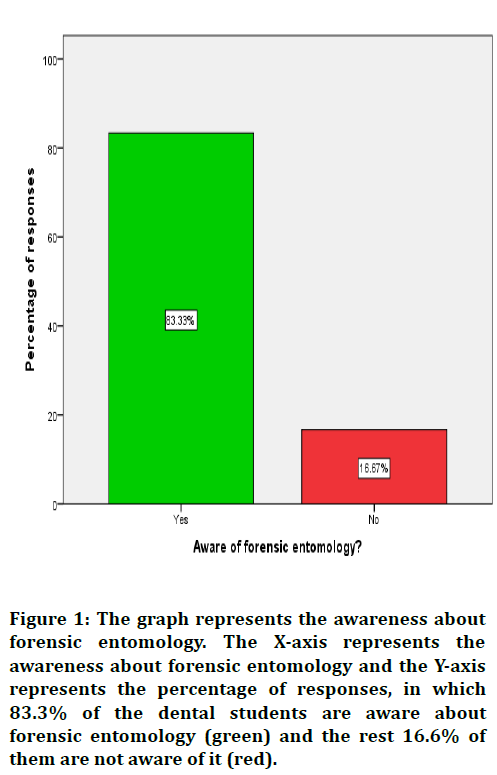
Figure 1. The graph represents the awareness about forensic entomology. The X-axis represents the awareness about forensic entomology and the Y-axis represents the percentage of responses, in which 83.3% of the dental students are aware about forensic entomology (green) and the rest 16.6% of them are not aware of it (red).
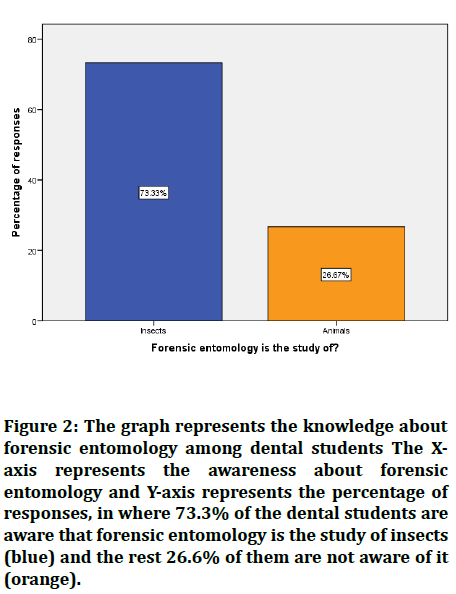
Figure 2. The graph represents the knowledge about forensic entomology among dental students The Xaxis represents the awareness about forensic entomology and Y-axis represents the percentage of responses, in where 73.3% of the dental students are aware that forensic entomology is the study of insects (blue) and the rest 26.6% of them are not aware of it (orange).
Figure 3 shows the knowledge about what is PMI, 56.6% of them are aware that PMI helps to determine and estimate the time of the deceased, 30% of the students have no idea about PMI is in general and the rest 13.3% of them are not aware.
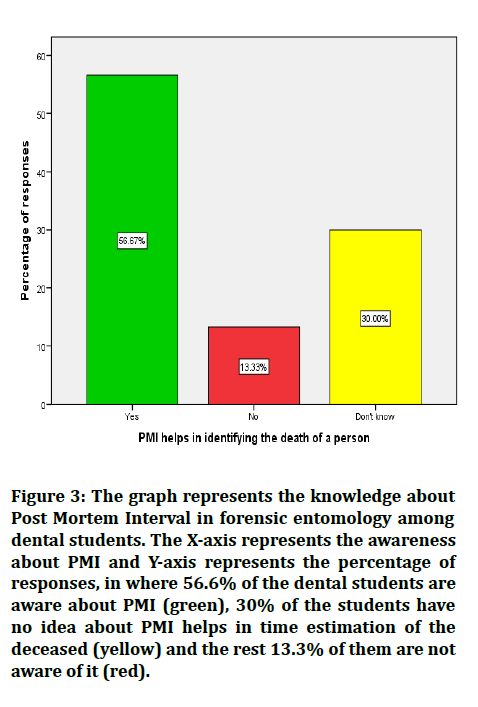
Figure 3. The graph represents the knowledge about Post Mortem Interval in forensic entomology among dental students. The X-axis represents the awareness about PMI and Y-axis represents the percentage of responses, in where 56.6% of the dental students are aware about PMI (green), 30% of the students have no idea about PMI helps in time estimation of the deceased (yellow) and the rest 13.3% of them are not aware of it (red).
Figure 4 shows the awareness of the dental students about PMI in forensic entomology, in which 56.7% of them are not aware about PMI and the rest 43.3% of the students are aware that PMI is related to forensic entomology in crime investigations. PMI also helps in determining the location of the death, 35% of them are aware that PMI also helps in finding the location of the crime scene, but majority (65%) of the students are not aware how they are interrelated to each other.
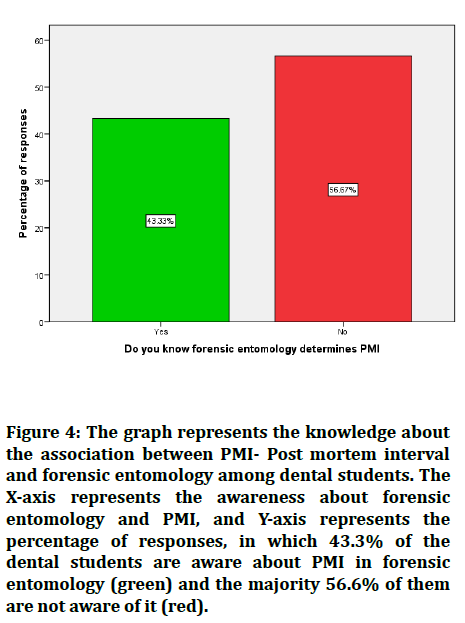
Figure 4. The graph represents the knowledge about the association between PMI- Post mortem interval and forensic entomology among dental students. The X-axis represents the awareness about forensic entomology and PMI, and Y-axis represents the percentage of responses, in which 43.3% of the dental students are aware about PMI in forensic entomology (green) and the majority 56.6% of them are not aware of it (red).
Figure
40% of the dental students believe blow flies, maggots and beetles are involved in forensic entomology, 30% of them are aware that blow flies are commonly used, 16.6% of them think maggots are commonly used (pink) and the rest 13.3% of them think its beetles are the most commonly involved insects in forensic entomology, shown in Figure 5. The awareness about the relation between forensic entomology and forensic odontology was assessed, 63.3% of them are aware that forensic entomology is linked with forensic odontology, and the rest 36.6% of them are not aware of the interrelation represented in Figure 6. 70% of the students are not aware of forensic endotoxicology and its relation to forensic entomology, and the rest 30% are aware of it.
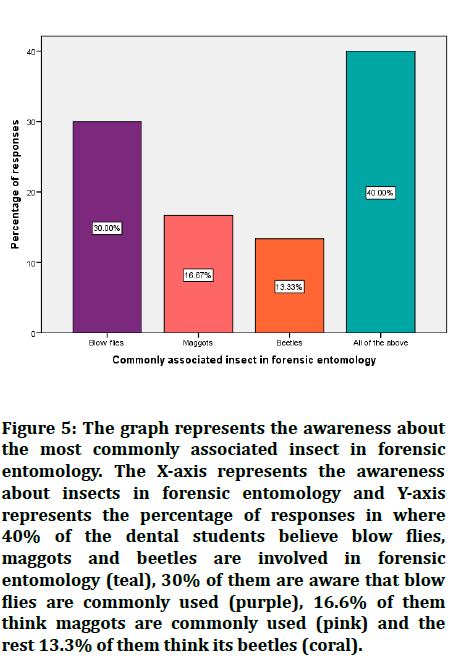
Figure 5. The graph represents the awareness about the most commonly associated insect in forensic entomology. The X-axis represents the awareness about insects in forensic entomology and Y-axis represents the percentage of responses in where 40% of the dental students believe blow flies, maggots and beetles are involved in forensic entomology (teal), 30% of them are aware that blow flies are commonly used (purple), 16.6% of them think maggots are commonly used (pink) and the rest 13.3% of them think its beetles (coral).
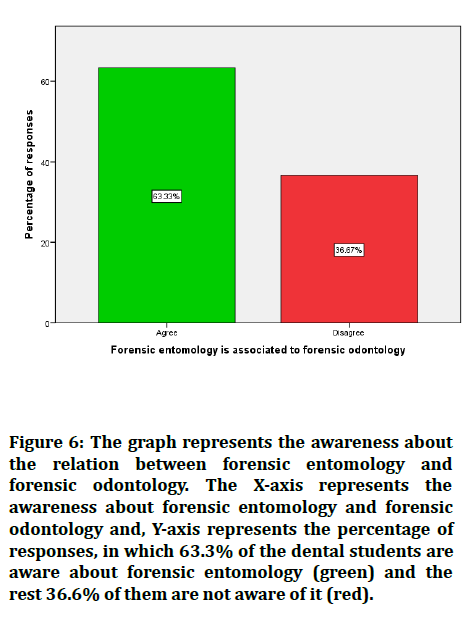
Figure 6. The graph represents the awareness about the relation between forensic entomology and forensic odontology. The X-axis represents theawareness about forensic entomology and forensic odontology and, Y-axis represents the percentage of responses, in which 63.3% of the dental students are aware about forensic entomology (green) and the rest 36.6% of them are not aware of it (red).
Discussion
The results were collected and analysed using SPSS software and found that the graph in Figure 1 represents the awareness about forensic entomology in where 83.3% of the dental students are aware about forensic entomology and the rest 16.6% of them are not aware of it and chi square test was performed to obtain p value and was 0.089 which is greater than 0.05 and is not statistically significant shown in Figure 7. Surveys to the related topics were not conducted in the past, but forensic entomology is considered to be an effective tool in forensic dentistry [31].
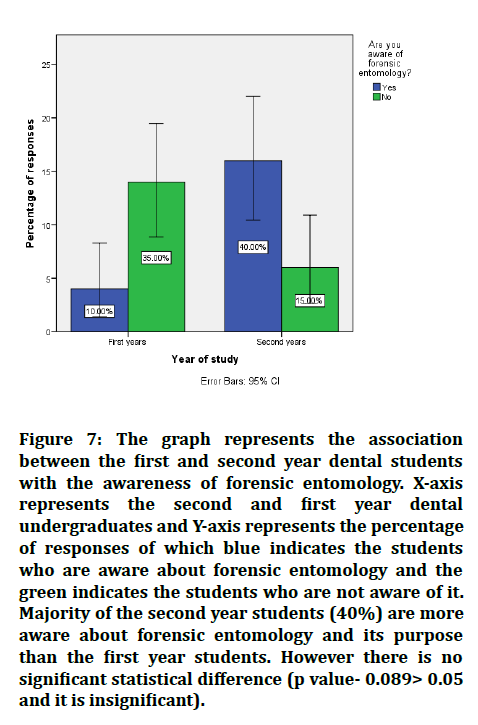
Figure 7. The graph represents the association between the first and second year dental students with the awareness of forensic entomology. X-axis represents the second and first year dental undergraduates and Y-axis represents the percentage of responses of which blue indicates the students who are aware about forensic entomology and the green indicates the students who are not aware of it. Majority of the second year students (40%) are more aware about forensic entomology and its purpose than the first year students. However there is no significant statistical difference (p value- 0.089> 0.05 and it is insignificant).
Forensic entomology is a scientific study of the invasions of different insects and arthropods [1,31]. So, in Figure 2, the percentage of students with knowledge about forensic entomology among dental students was assessed, in where 73.3% of the dental students are aware about forensic entomology is the study of insects and the rest 26.6% of them are not aware of it and chi square test was performed to obtain p value and was 1.512 which is greater than 0.05 and is not statistically significant shown in Figure 8. Forensic entomology details the explanation of the anatomy of each insect taxonomically which helps in determining the death of the deceased. It also deals with the molecular level of the insects to elaborate the crime scene [32,33]. This study of science particularly determines the PMI, the Post Mortem Interval. PMI is the time determined since the death of the person [34,35].
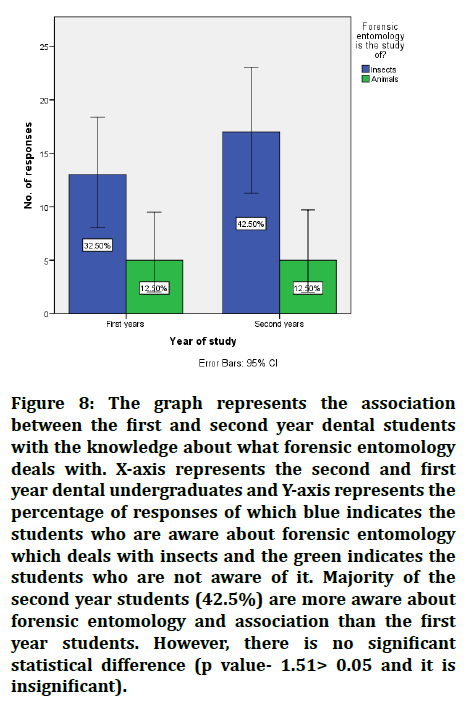
Figure 8. The graph represents the association between the first and second year dental students with the knowledge about what forensic entomology deals with. X-axis represents the second and first year dental undergraduates and Y-axis represents the percentage of responses of which blue indicates the students who are aware about forensic entomology which deals with insects and the green indicates the students who are not aware of it. Majority of the second year students (42.5%) are more aware about forensic entomology and association than the first year students. However, there is no significant statistical difference (p value- 1.51> 0.05 and it is insignificant).
The graph represented in Figure 3 assess the knowledge about Post Mortem Interval in forensic entomology among dental students, in where 56.6% of the dental students are aware about PMI, 30% of the students have no idea about PMI, which helps in time estimation of the deceased and the rest 13.3% of them are not aware of it and chi square test was performed to obtain p value, and was 0.127 which is greater than 0.05 and is not statistically significant shown in Figure 9. PMI is estimated by the forensic entomologist, who plays a massive role in homicide investigations [6]. They determine the role of insects in a homicide investigation; such insects are studied scientifically at molecular levels.
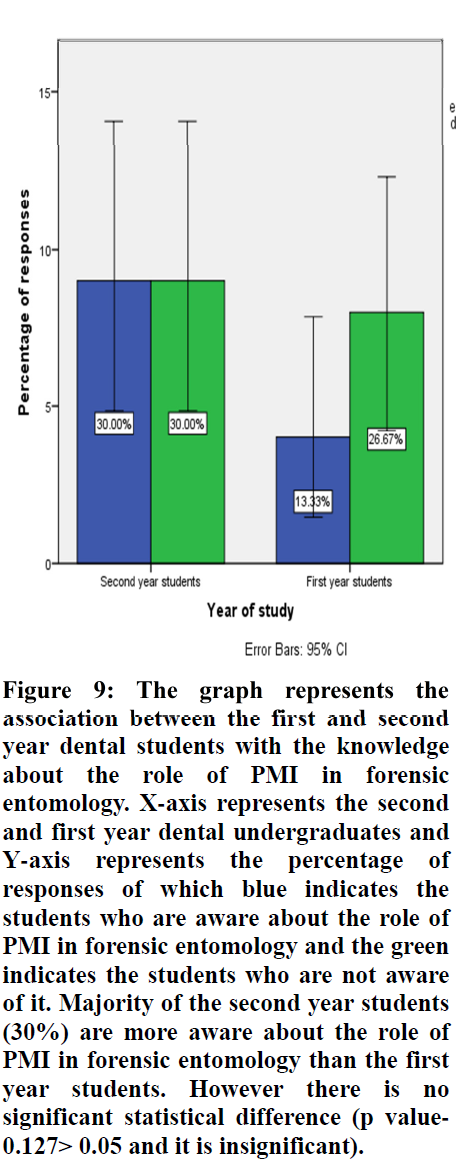
Figure 9. The graph represents the association between the first and second year dental students with the knowledge about the role of PMI in forensic entomology. X-axis represents the second and first year dental undergraduates and Y-axis represents the percentage of responses of which blue indicates the students who are aware about the role of PMI in forensic entomology and the green indicates the students who are not aware of it. Majority of the second year students (30%) are more aware about the role of PMI in forensic entomology than the first year students. However there is no significant
In Figure 4, the graph represents the knowledge about the association between PMI- Post mortem interval and forensic entomology among dental students, in which 43.3% of the dental students are aware about PMI in forensic entomology and the majority 56.6% of them are not aware of it.
The awareness about the most commonly associated insect in forensic entomology was assessed and represented in Figure 5, in where 40% of the dental students believe blow flies, maggots and beetles are involved in forensic entomology, 30% of them are aware that blow flies are commonly used, 16.6% of them think maggots are commonly used and the rest 13.3% of them think its beetles. Comparative findings state the most commonly associated insect in forensic investigations are blow flies [36]. Forensically blow flies are of great importance [37].
The graph in Figure 6 represents the awareness about the relation between forensic entomology and forensic odontology, in where 63.3% of the dental students are aware about forensic entomology and the rest 36.6% of them are not aware of it and chi square test was performed to obtain p value, and was 0.919 which is greater than 0.05 and is not statistically significant shown in Figure 10. The limitations of the present study were the sample population of only 100 dental undergraduate students. The responses collected may be biased on the knowledge about forensic entomology. Different levels of understanding ability of the participants may also produce slight differences and errors in the study.

Figure 10. The graph represents the association between the first and second year dental students with the awareness about the relation forensic entomology between forensic odontology. X-axis represents the second and first year dental undergraduates and Y-axis represents the percentage of responses of which blue indicates the students who are aware that forensic entomology is related to forensic odontology and the green indicates the students who are not aware of it. Majority of the second year students (60%) are more aware about forensic entomology associated with forensic odontology than the first year students. However there is no significant statistical difference (p value- 0.919> 0.05 and it is insignificant).
According to the present study, the awareness and knowledge about forensic entomology, their action and use in forensic investigations were assessed and were found to be above average. Majority of the students, 83.3% of the dental students are aware about forensic entomology. And more than 73% of the dental students are aware that forensic entomology is the study of insects. Knowledge of the students about other aspects is average. Further studies are needed to create more awareness about the interrelation between forensic entomology and other sourcing fields. More studies should be conducted on exploring this branch of knowledge to gain information about it as it plays an important role in the aspects of any medical expertise.
Conclusion
Thus the present study concludes that the awareness and knowledge about forensic entomology among dental students is above average, and the various aspects of forensic entomology are well known by the second year students than the first year students. Students are aware about the term forensic entomology and their purpose, but lack awareness and knowledge about relation with other fields. Further awareness about the practice and attitude about forensic entomology in relation to other technical fields must be created among dental students to improve their knowledge about it.
Authors Contribution
Taanya Imtiaz has done the survey preparation and the data collection, statistical analysis and manuscript preparation. Dr. Abirami Arthanari had edited and revised the manuscript of the present study.
Acknowledgement
We thank Saveetha Dental College for providing us the support to conduct the study.
Conflict of Interest
The authors have no conflict of interest.
Source of Funding
• Saveetha Institute of Medical and Technical science, Saveetha Dental College.
• Faamys Fashions.
References
- Amendt J, Krettek R, Zehner R. Forensic entomology. Naturwissenschaften 2004; 91:51-65.
- Fox EG. Current concepts in forensic entomology. Euro J Entomol 2011; 108:346.
- Byrd JH, Tomberlin JK. Forensic entomology: The utility of arthropods in legal investigations. CRC press 2019.
- Joseph I, Mathew DG, Sathyan P, et al. The use of insects in forensic investigations: An overview on the scope of forensic entomology. J Foren Dent Sci 2011; 3:89.
- Pai CY, Jien MC, Li LH, et al. Application of forensic entomology to postmortem interval determination of a burned human corpse: A homicide case report from southern Taiwan. J Formos Med Assoc 2007; 106:792-8.
- Catts EP, Goff ML. Forensic entomology in criminal investigations. Ann Rev Entomol 1992; 37:253-72.
- Higley LG, Haskell NH, Byrd JH, et al. Insect development and forensic entomology. Forensic Entomol 2001; 287-302.
- Benecke M. A brief history of forensic entomology. Forensic Sci Int 2001; 120:2-14.
- Benbow ME. Applications of soil chemistry in forensic entomology. Forensic Entomol 2015; 306-319.
- Sukontason K, Narongchai P, Kanchai C, et al. Forensic entomology cases in Thailand: a review of cases from 2000 to 2006. Parasitol Res 2007; 101:1417-23.
- Santhakumar P, Prathap L. Awareness on preventive measures taken by health care professionals attending COVID-19 patients among dental students. Euro J Dent 2020; 14:S105-9.
- Mathew MG, Samuel SR, Soni AJ, et al. Evaluation of adhesion of Streptococcus mutans, plaque accumulation on zirconia and stainless steel crowns, and surrounding gingival inflammation in primary molars: Randomized controlled trial. Clin Oral Inves 2020; 24:3275-80.
- Sridharan G, Ramani P, Patankar S, et al. Evaluation of salivary metabolomics in oral leukoplakia and oral squamous cell carcinoma. J Oral Pathol Med 2019; 48:299-306.
- Hannah R, Ramani P, Ramanathan A, et al. CYP2 C9 polymorphism among patients with oral squamous cell carcinoma and its role in altering the metabolism of benzo [a] pyrene. Oral Surg Oral Med Oral Pathol Oral Radiol 2020; 130:306-12.
- Antony JV, Ramani P, Ramasubramanian A, et al. Particle size penetration rate and effects of smoke and smokeless tobacco productsâ??An invitro analysis. Heliyon 2021; 7:06455.
- Sarode SC, Gondivkar S, Sarode GS, et al. Hybrid oral potentially malignant disorder: A neglected fact in oral submucous fibrosis. Oral Oncol 2021; 105390.
- Hannah R, Ramani P, Tilakaratne WM, et al. Critical appraisal of different triggering pathways for the pathobiology of pemphigus vulgaris-A review. Oral Dis 2021.
- Chandrasekar R, Chandrasekhar S, Sundari KS, et al. Development and validation of a formula for objective assessment of cervical vertebral bone age. Prog Orthodon 2020; 21:1-8.
- Subramanyam D, Gurunathan D, Gaayathri R, et al. Comparative evaluation of salivary malondialdehyde levels as a marker of lipid peroxidation in early childhood caries. Euro J Dent 2018; 12:067-70.
- Jeevanandan G, Thomas E. Volumetric analysis of hand, reciprocating and rotary instrumentation techniques in primary molars using spiral computed tomography: An in vitro comparative study. Euro J Dent 2018; 12:021-6.
- Ponnulakshmi R, Shyamaladevi B, Vijayalakshmi P, et al. In silico and in vivo analysis to identify the antidiabetic activity of beta sitosterol in adipose tissue of high fat diet and sucrose induced type-2 diabetic experimental rats. Toxicol Mech Meth 2019; 29:276-90.
- Sundaram R, Nandhakumar E, Haseena Banu H. Hesperidin, a citrus flavonoid ameliorates hyperglycemia by regulating key enzymes of carbohydrate metabolism in streptozotocin-induced diabetic rats. Toxicol Mech Meth 2019; 29:644-53.
- Alsawalha M, Rao CV, Al-Subaie AM, et al. Novel mathematical modelling of Saudi Arabian natural diatomite clay. Mat Res Exp 2019; 6:105531.
- Yu J, Li M, Zhan D, et al. Inhibitory effects of triterpenoid betulin on inflammatory mediators inducible nitric oxide synthase, cyclooxygenase-2, tumor necrosis factor-alpha, interleukin-6, and proliferating cell nuclear antigen in 1, 2-dimethylhydrazine-induced rat colon carcinogenesis. Pharmacogn Mag 2020; 16:836.
- Shree KH, Ramani P, Sherlin H, et al. Saliva as a diagnostic tool in oral squamous cell carcinoma: A systematic review with meta-analysis. Pathol Oncol Res 2019; 25:447-53.
- Zafar A, Sherlin HJ, Jayaraj G, et al. Diagnostic utility of touch imprint cytology for intraoperative assessment of surgical margins and sentinel lymph nodes in oral squamous cell carcinoma patients using four different cytological stains. Diag Cytopathol 2020; 48:101-10.
- Karunagaran M, Murali P, Palaniappan V, et al. Expression and distribution pattern of podoplanin in oral submucous fibrosis with varying degrees of dysplasiaâ??an immunohistochemical study. J Histotechnol 2019; 42:80-6.
- Sarode SC, Gondivkar S, Gadbail A, et al. Oral submucous fibrosis and heterogeneity in outcome measures: a critical viewpoint. Future Oncol 2021; 17:2123-6.
- Preeth DR, Saravanan S, Shairam M, et al. Bioactive Zinc (II) complex incorporated PCL/gelatin electrospun nanofiber enhanced bone tissue regeneration. Euro J Pharmaceu Sci 2021; 160:105768.
- Prithiviraj N, Yang GE, Thangavelu L, et al. Anticancer compounds from starfish regenerating tissues and their antioxidant properties on human oral epidermis carcinoma kb cells. In: pancreas. 2020; 155â??6.
- Kapoor P, Chowdhry A. Salivary signature in forensic profiling: A scoping review. J Forens Dent Sci 2018; 10:123.
- Merritt RW, Wallace JR. The role of aquatic insects in forensic investigations. Forensic Entmol The utility of arthropods in legal investigations. 2001; 177-222.
- Gennard D. Forensic entomology: an introduction. John Wiley & Sons. 2013; 248.
- Donaldson AE, Lamont IL. Biochemistry changes that occur after death: potential markers for determining post-mortem interval. PloS one 2013; 8:82011.
- Wescott DJ. The forensic anthropologist as broker for cross-disciplinary taphonomic research related to estimating the postmortem interval in medicolegal death investigations. Forensic anthropology: theoretical framework and scientific basis. Wiley 2018; 251-70.
- Sukontason K, Piangjai S, Siriwattanarungsee S, et al. Morphology and developmental rate of blowflies Chrysomya megacephala and Chrysomya rufifacies in Thailand: application in forensic entomology. Parasitol Res 2008; 102:1207-16.
- Bunchu N, Thaipakdee C, Vitta A, et al. Morphology and developmental rate of the blow fly, Hemipyrellia ligurriens (Diptera: Calliphoridae): Forensic entomology applications. J Parasitol Res 2012; 2012.
Indexed at, Google Scholar, Cross Ref
Indexed at, Google Scholar, Cross Ref
Indexed at, Google Scholar, Cross Ref
Indexed at, Google Scholar, Cross Ref
Indexed at, Google Scholar, Cross Ref
Indexed at, Google Scholar, Cross Ref
Indexed at, Google Scholar, Cross Ref
Indexed at, Google Scholar, Cross Ref
Indexed at, Google Scholar, Cross Ref
Indexed at, Google Scholar, Cross Ref
Indexed at, Google Scholar, Cross Ref
Indexed at, Google Scholar, Cross Ref
Indexed at, Google Scholar, Cross Ref
Indexed at, Google Scholar, Cross Ref
Indexed at, Google Scholar, Cross Ref
Indexed at, Google Scholar, Cross Ref
Indexed at, Google Scholar, Cross Ref
Indexed at, Google Scholar, Cross Ref
Indexed at, Google Scholar, Cross Ref
Indexed at, Google Scholar, Cross Ref
Indexed at, Google Scholar, Cross Ref
Indexed at, Google Scholar, Cross Ref
Indexed at, Google Scholar, Cross Ref
Indexed at, Google Scholar, Cross Ref
Author Info
Taanya Imtiaz and Abirami Arthanari*
Department of Forensic Odontology, Saveetha Institute of Medical and Technical Sciences, Saveetha University, Chennai, IndiaCitation: Taanya Imtiaz, Abirami Arthanari, Knowledge and Awareness about Forensic Entomology in India among Dental Students , J Res Med Dent Sci, 2022, 10(1): 212-218
Received: 14-Dec-2021, Manuscript No. JRMDS-21-41696; , Pre QC No. JRMDS-21-41696 (PQ); Editor assigned: 16-Dec-2021, Pre QC No. JRMDS-21-41696 (PQ); Reviewed: 30-Dec-2021, QC No. JRMDS-21-41696; Revised: 04-Jan-2022, Manuscript No. JRMDS-21-41696 (R); Published: 11-Jan-2022
